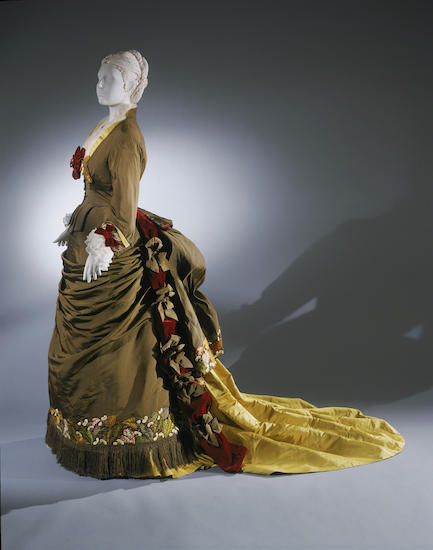Artist Birthday: Charles Worth
Charles Frederick Worth was undoubtedly one of the most influential fashion designers in the West in the latter half of the 1800s. He is credited with making the hoop skirt (crinoline) popular, and is considered one of the earliest, if not the earliest haute couture (high fashion) house in Paris.
Artist Birthday for 13 October: Charles Worth (1825-1895 France, born Britain)
 |
| Charles Worth, Day Dress, ca. 1875, silk faille with silk satin, silk velvet, embroidered appliqué, sheer pleated silk, silk fringe, and artificial flowers, length in center back: 127 cm © 2025 Philadelphia Museum of Art (PMA-9530) |
The crinoline, or hoopskirt, dominated fashion of the 1850s through the 1860s. Although Worth did not design the original bell-shaped skirt of the 1850s which became the larger crinoline, he did modify its design. Instead of numerous petticoats to support the voluminous skirt, Worth replaced them with a light-weight metal "cage" with the emphasis on fullness in the back rather than all around. The hoopskirt reached its greatest width between 1865 and 1867, assuming a large cone-like shape. Because it could get no bigger, between 1868 and 1870 the crinoline cage was downsized to a smaller cage construction in the back covered with material and augmented by pads called a "bustle."
The bustle endured in one form or size until about 1891. The bustle was known as a "tie-back skirt" because of the draped panel in front that culminated on the bustle, often ornamented with a large bow. The front panel on this Worth design is draped and caught up under the poofy material atop the bustle. Worth's designs were renowned for historical references to previous period fashions. The ruching (a gathered overlay of fabric strips that are pleated, fluted, or gathered together to create a ripple-like effect) decoration on the side of the train was a harking back to the elaborate decorated panier (side-hoops) of the mid- to late 1700s. In 1875, the bustle dress was popular with a train. Trains went in and out of favor through the rest of the 1870s and 1880s.
Background
Body coverings – clothing – were devised by pre-historic people as a form of protection from the elements. Clothing has been in a constant state of change ever since. The factors affecting these changes are sociological and political, technical advances and production capabilities, and aesthetic and cultural concepts. When pre-historic garments evolved into costumes with decoration, so began the world of fashion.
The particular forms of fashion are used by individuals from every time period – except in the case of the most humble elements in society – to identify their status, sophistication or taste. Social concepts are reflected in both subtle and blatant ways in the ever-changing aesthetics of fashion. In essence, fashion is a way in which individuals can make aesthetic judgments or statements.
Beginning in the mid-1800s was the phenomenon known to this day as haute couture (pronounced "hote kootoor") "high" or "refined" dressmaking in French. The British designer Charles Worth (1825-1895) is credited with opening the first haute couture house in 1858 in Paris. Worth will be remembered as the popularizer of the crinoline, or hoopskirt of the 1860s. French high fashion culture was codified with the 1868 formationof the Haute Couture and Fashion Federation, which established annual men's and women's fashion weeks. In 2021, the Federation instituted steps to finally move the fashion design industry towards sustainability and cutting the carbon footprints of the fashion houses.
Charles Worth, born in Bourne, Lincolnshire, was not the first fashion designer, but he was the first male fashion designer and a dominant voice in fashion evolution during the last half of the 1800s. As a young man he apprenticed for London textile merchants where he gained thorough knowledge of textiles and supplying of fashion designers. He also studied portraits from past periods for details of dress at the National Gallery, compiling a knowledge of fashion details from ages past for his future designs for women's clothing.
Moving to Paris in 1845, he worked at Gagelin, a prominent textiles firm that sold shawls and some ready-made clothing. He opened a small dressmaking department, his first stab at being a fashion designer. After scoring prizes for his designs for Gagelin at the Great Exposition (London, 1851), he opened his own couture house in Paris. His rise as a fashion designer coincided with the restoration of the French Empire under Napoleon III (1808-1873). The modernization of Paris under Napoleon III along with the increase in imperial state occasions increased the demand for luxury, fashionable dress to heights not seen in Paris since before the French Revolution (1789-1799). Paris became a cultural, artistic and architectural focal point of Europe, and with the Empress Eugenie's (1826-1920) patronage, Worth's success was ensured from the 1860s onward.
Worth built his design house into a huge business which thrived even after the fall of Napoleon III (1871). Being the first male fashion designer for women was not Worth's only first. He also invented the idea of interchangeable dress patterns where sleeve or bodice designs could accommodate numerous outfits. He was also the first fashion designer to host "runway shows" where models wore entire outfits he designed rather than accessories, so that clients could see what a complete design looked like. The house flourished into the 1920s under his sons, but finally closed when his great-grandson Roger (1908-1984) retired from the house in 1952 and it was sold to the House of Paquin.

Comments